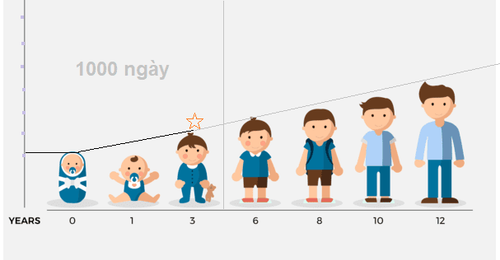This is an automatically translated article.
The article is professionally consulted with Master, Doctor Nguyen Minh Tuan - Pediatrician - Pediatrics - Neonatology - Vinmec Da Nang International Hospital
The average height of young Vietnamese people has changed positively in recent years. Specifically, the average height of young Vietnamese men is 168.1cm; female reaches 156.2cm. Statistics show that the average height of Vietnamese people has increased by more than 3cm compared to the results 10 years ago, helping us no longer belong to the group of "the shortest in Southeast Asia".
1. Average height increase of Vietnamese people in the past 10 years
The Ministry of Health has just announced the results of a survey conducted by the General Statistics Office and the National Institute of Nutrition in the year 2019 - 2020. Accordingly, young Vietnamese men have an average height of 168.1cm; while women reach 156.2cm. The height of urban children is 2cm higher than that of rural children, especially in poor rural areas, areas prone to natural disasters and mountainous areas.
So compared to 10 years ago, the average height of young men has increased by 3.7cm, while girls in our country have increased by 2.6cm. In particular, the height of Vietnamese born from 2000 onwards is better than in the previous period, the high speed is nearly twice as fast as the previous decade.
With this new height statistics of Vietnamese people, nutrition experts say that our young people not only "get rid of short", but are also ranked in the top 4 tallest countries in Southeast Asia. The average height of young Vietnamese men and women is similar to Malaysia, only losing to Singapore and Thailand. If the height of Vietnamese people is compared with the world, the Ministry of Health estimates that the growth of Vietnamese youth in the period 1990-2020 is equivalent to the golden period of height increase of Japan (1955-1995) and European countries. late 19th century, early 20th century. To close the height gap with Asia's top tall countries (like South Korea), we need to maintain growth over the coming decades.
2. Efforts to improve the height of Vietnamese people
There are positive results when counting the height of Vietnamese people this time thanks to interventions over the past 20 years. Therefore, it is not surprising that the average height of Vietnamese people compared to 10 years ago increased from 2.6 to 3.7cm in women and young men in this statistic.
In recent decades, Vietnam has taken height measurements every 10 years. The National Institute of Nutrition said that this survey was conducted in late 2019 and early 2020, with a sample size of 22,000 people living in all regions of Vietnam. Particularly, the group of young people under 25 years old was measured to find out about height. This survey is the largest ever and has US CDC experts to help and verify the sample.
The subjects participating in this survey were mainly born in the 2000s - the period when our country started to intervene in nutrition, support growth from the first 1,000 days of life and later on school nutrition, deworming, vitamin supplements ... Meanwhile, the last measurement was conducted with those born in 1990 or earlier, at a time when our country did not have much intervention in nutrition and economic difficulties.
Also through the 2020 survey, the rate of stunting among Vietnamese children under 5 years old is 19.6%, lower than 20% for the first time. As a result, Vietnam is considered a country with a low level of malnutrition according to WHO classification in 1997.

3. Nutrition affects the height of Vietnamese people
Compared to 10 years ago, the average energy in the diet of our people reached 2,023 kcal/person/day, a slight increase compared to 2010 (1,925 kcal/person/day). Accordingly, Vietnamese people also eat more vegetables, per capita increased from 190.4 g of vegetables/person/day in 2010 to 231 g. In 2010, Vietnamese people only ate 60.9 g of ripe fruit per day, now it has increased to 140.7 g. However, compared to the nutritional recommendations for adults, this consumption level is only 66-77%.
In addition, Vietnamese people also eat more meat. Currently, the average person eats 136.4 g of meat per day, while in 2010 only consumed 84 g. Especially people in the city eat the most meat, about 155.3 g of meat/person/day.
Because the first 3 years of life is an important milestone for children to grow in height, the percentage of children who are breastfed also needs attention. Over the past 10 years, from 19.6% of families exclusively breastfeeding for the first 6 months has improved significantly to more than 45%. This percentage is also higher in urban areas than elsewhere.
Moreover, people have more and more knowledge and correct practices about food safety and are interested in growing taller. Nearly 36% of people have good knowledge, nearly 56% have average and only about 9% answer poorly.
The results of this survey on Vietnamese height and nutrition will help experts guide the development of a national strategy in the new period. Particularly for parents, it is necessary to pay attention to nutrition for the first 1,000 days of their child's life - the only period that helps children grow in height over 10-14 cm/year if they are well cared for. Women, right from the time they prepare for pregnancy, need to eat and supplement with adequate micronutrients.
Follow Vinmec International General Hospital website to get more health, nutrition and beauty information to protect the health of yourself and your loved ones in your family.
Please dial HOTLINE for more information or register for an appointment HERE. Download MyVinmec app to make appointments faster and to manage your bookings easily.
Note: This article is part of the Vinmec International General Hospital System's Awareness Program on Growth Retardation, with the support of Novo Nordisk













